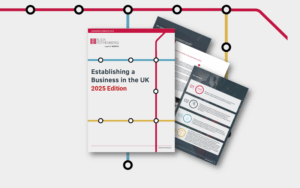Don’t be caught out by Corporation Tax rate change
A new 25% rate of Corporation Tax will be introduced from 1 April 2023 where the profit is £250,000 or more. The current rate of 19% will continue, but only for companies with a profit below £50,000; and any company with a profit of between £50,000 and £250,000 will be subject to a tapered rate between 19% and 25%.
There’s no doubt that the change is unwelcome for companies with profits over the £250,000 threshold, but the rules also bring some unexpected consequences that companies of all sizes may need to consider:
It is poorly understood that a company with a financial year that straddles 1 April 2023 will be subject to a blended rate of Corporation Tax – taking account of the length of period falling either side of 1 April. For example, a company with a financial year ending on 31 December 2023, with profits of £1 million, will be subject to a blended rate of 23.5% on its profits for the entire 12 months. We are aware, however, that some companies are being advised to accelerate profits (for example, by advancing a property sale) before 1 April 2023 to benefit from the lower rate of 19%. Unfortunately, this advice is wrong. It is only possible to apportion profits for an accounting period based on the number of days before and after the change in rate. A gain on a property sale in March 2023 will therefore be taxed at 23.5% assuming it falls in a 12-month accounting period ending 31 December 2023. The only way to take advantage of the lower rate until 31 March 2023 is to shorten the financial year. So, a company with an accounting reference date of 31 December, for example, can change the date to 31 March. This will mean a three-month accounting period to 31 March 2023 in which any profit will be subject to Corporation Tax at 19%. Remember too that the disposal date for the sale of an investment property for tax purposes is the date on which the contract becomes unconditional. Changing the accounting reference date is straightforward and can be done at any time except when the accounts are overdue.
It should also be remembered that the profit thresholds of £50,000 and £250,000 only apply to a company without any so-called ‘associated companies’. If a company has one other ‘associated company’, the thresholds are divided by two (the company itself and its associated company). A company with nine associated companies must divide the thresholds by ten, so the limits become £5,000 and £25,000. As you can see, the rules can bring relatively small profits into the higher rate of tax. Moreover, companies are treated as ‘associated’ with each other if one controls the other or both companies are controlled by the same person or persons. Group companies will usually be associated but so will companies under the control of an individual or family. Further complications arise with trust and partnership structures and so the rules can become a bear-trap for the uninformed.
While the tax rate on profits between £50,000 and £250,000 is sensibly reduced from 25% to 19% by a tapering fraction, the formula actually results in a marginal rate of tax of 26.5%! Any opportunity to reduce taxable profits when paying a tapered rate should therefore be prioritised. Groups in particular, may be able to take advantage of cross-charges or group relief to ensure profits bear tax at the lowest possible rate.
Would you like to know more?
If you would like to discuss any of the above in more detail, please contact your usual Blick Rothenberg contact or Neil Insull, using the details on this page or the form below.
Contact Neil

You may also be interested in

A ray of hope for the Property Market: HMRC transaction data suggests recovery momentum

Spotlight on…Are you ready for the FCA’s proposed Stablecoin & Crypto Custody rules?













